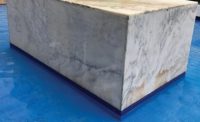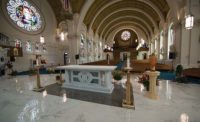A team of artists at Rookwood Pottery Co. of Cincinnati, OH, “worked meticulously to replace the tiles originally handcrafted by their long-ago counterparts in 1911,” according to the company. They dedicated years to studying original construction documents, early photographs, and chemistry and historic material retrieved from the site. Their efforts did not go unnoticed, as the company recently received a “Special Recognition” in the first Coverings Installation & Design Competition.
“When I first looked at what was needed to be done, it didn’t appear all that complicated,” said Jon Williams, Ceramist at Rookwood, adding that he and his wife have been in the tile business for 30 years. “But because it was all made and fired in 1911 and installed in 1912, the material used was totally different. When looking at samples of tile that were already installed, I saw four different clay bodies.”
Williams explained that one of the main differences between the original tile and tile produced today lies in the production process. “We are firing in an electric kiln now,” he said. “Everything is very consistent. We needed to mimic the variation that was in the original tile, and we were not certain what they were firing with at the time.
“They got a lot of variation due to different temperatures in the kiln,” Williams went on to say. “The one part closer to the burner would look one way, and the one farther away would look a different way. [In the end], we had to come up with three different blacks, three different taupes and two different beige/pink colors. There was a green/black, blue/black and rich black.”
Another issue that had to be considered was slip resistance. “Back in 1912, if someone slipped on wet tile, it was not a big deal,” said Williams. “The liability issue wasn’t there. They used lead in their glazes so the tile was a little softer, and it would get wear patterns. The issue was that we had to develop a base glaze that would meet today’s standards. We had to send it off to the Tile Council of North America (TCNA) to be tested for abrasion — that also restricted what we could do with color.”
In addition to the floor tile, Rookwood also replicated the original wall tile. “The tile on the walls was pink/beige and crackled,” explained Williams. “When we made the tile, we not only had to match the color, but we also had to make it look old and dirty as well. We had to reformulate a clay body that causes the glaze to be slightly absorbent to hold on to crackle lines.”
According to Williams, at some point during the building’s history, terrazzo was put over the original tile floor on the lower level, and the floors on the upstairs had been carpeted over. “A lot of tile was not salvageable because of glue/mastic on the tile,” he said.
Williams explained that Rookwood has been working on the restoration of the Monroe Building for roughly two years. “One interesting fact to me is that it only took a year to build the building,” he said. “We can’t figure out how they did it. They didn’t have tile saws — almost all the pieces on the downstairs were all put together when the clay was wet and then glazed and fired. I think they had such a different labor force. They sure had incredible draftsmen that could lay out on paper and good craftsmanship.”






